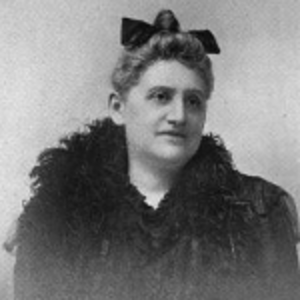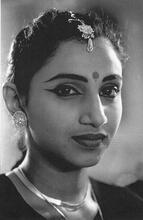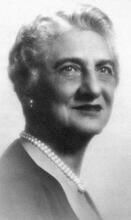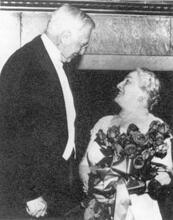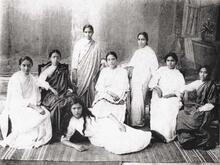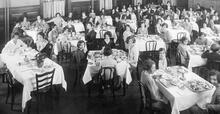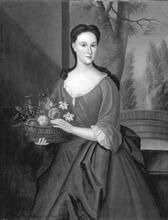Lina Frank Hecht
Lina Frank Hecht found creative ways to help poor immigrants help themselves, from technical schools to her unusual Hebrew Ladies Sewing Circle. Hecht married in 1867 and moved to Boston, where she began her philanthropic career by funding educational and health services for Eastern European immigrants. For the next decade, she and her husband worked to streamline Boston’s main Jewish charity, the United Hebrew Benevolent Association, to ensure fair and consistent aid for the poor. In the late 1880s she created a Jewish Sunday school for immigrants, which she expanded in 1890 as the Hebrew Industrial School for Girls, followed by a boys’ school two years later.
Called “Mrs. Hecht” by her colleagues and “Aunt Lina” by three generations of immigrant children in Boston, Lina Frank Hecht was Boston’s premiere Jewish female philanthropist of the late nineteenth and early twentieth centuries.
Early Life and Philanthropy
Born in 1848 in Baltimore to wealthy Bavarian immigrants, Lina received a private education and moved in Baltimore’s elite Jewish circles. In 1867, she married Jacob Hecht (born 1834), who had immigrated to America in 1848, established a wholesale shoe business with his family in California, Baltimore, and Boston, and who, by the time he met Lina, was already a wealthy man. The couple moved to Boston and became leading members of the German Jewish philanthropic community. Uniquely in her time and society, Lina Hecht established her independent identity as a female philanthropist and social reformer.
Hecht began her career in the 1870s, funding small educational and health services programs for Boston’s newly arriving Eastern European immigrants. In 1878, she revived, as its president, the Hebrew Ladies Sewing Circle (founded 1869). The group bought cloth that they paid immigrant women to sew into blankets, clothing, and undergarments; the results were then distributed free to needy Jewish immigrants. Hecht initiated fund-raising “Calico Balls” to support the circle’s Lit. "dedication." The 8-day "Festival of Lights" celebrated beginning on the 25th day of the Hebrew month of Kislev to commemorate the victory of the Jews over the Seleucid army in 164 B.C.E., the re-purification of the Temple and the miraculous eight days the Temple candelabrum remained lit from one cruse of undefiled oil which would have been enough to keep it burning for only one day.Hanukkah parties for the poor. Throughout the late 1870s and 1880s, she worked with her husband to professionalize Boston’s major Jewish charitable organization, the United Hebrew Benevolent Association (UHBA), ensuring uniform and rationalized services to the city’s Jewish poor. When the UHBA merged with four other Boston Jewish charities in April 1895 to form the first federated Jewish charitable organization in the nation—the Federation of Jewish Charities—Lina Hecht organized the fund-raisers to help make the merger financially possible and was one of only three women appointed to its founding board. “We must be as one family,” she told the major donors, encapsulating her lifelong vision for the Jewish community. Childless, Hecht often commented that she viewed all of Boston’s Jewish children as her own.
Educational Institutions and Legacy
In the late 1880s, Hecht started a Jewish Sunday school for immigrant children, hoping to teach them the basics of Judaism and an American way of life. With advice from social activist Golde Bamber, Hecht expanded those efforts in 1890 and founded the Hebrew Industrial School for Girls (HIS), a pioneering settlement house in Boston’s North End. A partner HIS for boys opened in Boston’s West End in 1892, and for four decades the schools taught good citizenship, Jewish history and culture, and economic self-sufficiency to immigrant children and their families. Following her death in 1921, the school purchased new headquarters in Boston’s West End with monies left in Hecht’s bequest, and the school was renamed the Hecht Neighborhood House in her honor. The name followed the community center to Boston’s Dorchester neighborhood in 1936 and bore her name through the 1970s.
Jacob Hecht died in 1902. Rare for a woman of her time, Lina Hecht continued her philanthropic leadership alone for the next two decades. In 1908, she was the first female named to the vice presidency of the Federated Jewish Charities. It was not the first time she was so honored and acknowledged. Rabbi Solomon Schindler’s 1889 publication, Israelites in Boston, had featured short biographies of Boston’s leading Jewish citizens. All his biographies were of men. But the frontispiece to the volume featured a photograph of Boston’s premiere Jewish charitable leader and citizen: Lina Frank Hecht.
Combined Jewish Philanthropies of Greater Boston. Papers. American Jewish Historical Society, Waltham, Mass..
Hecht Neighborhood House. Papers. American Jewish Historical Society, Waltham, Mass..
Schindler, Solomon. Israelites in Boston (1889).
Solomon, Barbara Miller. Pioneers in Service: The History of the Associated Jewish Philanthropies of Boston (1956).

